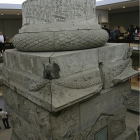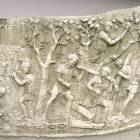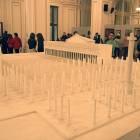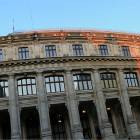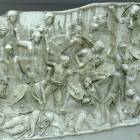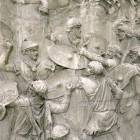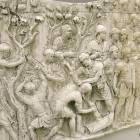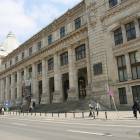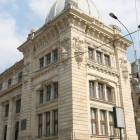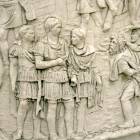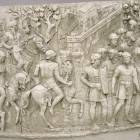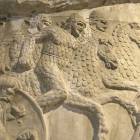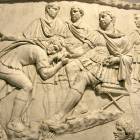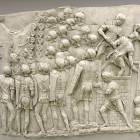Up-close with the Dacians from the column of Trajan in the History Museum
Romanians seem to be fascinated by their ancestry, after all, they are the only modern nation to draw its name from the mighty Roman Empire. Though the historic sources are scarce and debatable, for some modern nationalists the Dacians, who were the local population, before being conquered by the Romans, are more attractive than the famous empire. For some it’s the heroic resistance of the Dacians, lead by their great king, Decebalus, who committed suicide after losing the battle, for others it’s just a rejection of the Western culture, equating over time the European Union with the Roman Empire. For others are the mysterious culture and religion of the Dacians, that make them devour every archeological remain of early antiquity.
Dacians and Romans changed place over time in popular preferences for the favorite ancestor title. And a form of patriotism was always intertwined with this preoccupation for the past. Traditionally, the elites have favored the Romans. And we are not talking only about those of the Enlightenment. Surrounded and confronted with powerful empires, like the Ottoman and Hungarian empire, even the first medieval scholars underlined the Roman origin of the Romanian people. “We all come from Rome” was a common refrain in the medieval chronicles written in all Romanian historic provinces, like Moldova, Wallachia and Transylvania.
The national zeal faded away for some centuries during the time in which the Ottoman Empire imposed an almost colonial system here. Local elites looked for a way to accommodate the conquerors and instead of reaffirming the national ethos, resigned to preserving the Christian Orthodox heritage of the Byzantines. Ironically they were precisely the sons of these “collaborators”, educated in the West on their parents money, that would fuel a liberal revolution in the country, reinvent it and unite it for the first time since the Dacians. Fascinated by the ideas of the French Revolution and by the national state built by Napoleon, these new bourgeois chose only the approximate borders of the Dacian kingdom, but remembered the Romans as the natural link of Romanians with the admired modern nations of Europe. For generations of excellent intellectuals, the Latin descent meant that the Romanians might be capable if not of a French Revolution, at least of an Italian unification Garibaldi style. And indeed, for one or two centuries, until the fracture marked by the Soviet conquest during the second world war and the subsequent communist regime of half of century, reintegration in the modern Latin and European family was a national goal, followed in a rapid pace of modernization.
The reactionary response was to unearth the Dacian branch of the family. Those who saw Western institutions as a foreign import looked back to a traditional, rural, way of living or to a heroic and independent model. Romantics were rebels by definition and they came up with their own version of revolution: nationalism. This viewed the nation not as a political idea, but as a living organism, with a legendary past, a personal will and soul. Allover Europe, scores of talented writers rejected institutions and even Christianity as foreign and returned to the ancient local tribes and their warrior civilization. Some even went a step further, by melting early Darwinist and genetic theories, to obtain racist theories, that explained everything in the present through genes and ancestry. The Dacians were again popular.
Ironically again, the monument that celebrated the victory of Roman Empire over Dacia, the column of Trajan, proved to be the best source for knowing the Dacians. In a period when fascism was popular, a group of Romanian intellectuals started a project of replicating the column in Rome for the History Museum in Bucharest. After years of tribulations and war, that replica became centerpiece of the National History Museum in Bucharest. It is another irony as this happened during the dictatorship of Nicolae Ceausescu, who was an internationalist in his youth, like the rest of communists, but later discovered the value of nationalism as a political weapon. So strong was the conversion of Ceaușescu to nationalism in its most primitive form, that his propaganda started showing him as a natural follower to the throne of Dacian kings Burebista and Decebalus. Following the theatrical festivities ordered by the Shah of Iran, Reza Pahlavi, who presented himself as successor of Persian emperors Cyrus and Darius, Ceaușescu celebrated 2050 years of Romanian statehood.
This type of madness was only surpassed by the contemporary wild theories of the internet age. Cohorts of fans now watch in ecstasy amateur documentaries that maintain that the Dacians are a people of Biblical age, are at the origin of most of European nations, languages and inventions, and can even be traced back to the Trojan people, that the Aeneid presents as the mythical ancestors of the Latins. Conveniently, both the admirers of the Romans and of the Dacians fast forward over the long centuries in which migratory tribes controlled the space around the Carpathians and the banks of Danube. No one wants to present himself as the descendant of the Ostrogoths, Huns, Visigoths, Cumans or Pechenegs.
Unfortunately, most of the information we have on the Dacians comes from accidental accounts by travelers and Greek chroniclers. It is even impossible to trace the distinctions and borders between Thracians, Getaes and Dacians. As for the language of the Dacians, linguists are left with a group of words, not assigning the basic activities, about which they assume were of Dacian origin, as a different etymology could not be traced. We don’t even know whether the Dacians were monotheistic or polytheistic. Their most famous god was Zalmoxis, a fascinated character, to which they would bring human sacrifices, but we also know of other deities, such as Gebeleisis, a thunder god similar to the northern Thor. The rapid adoption of Christianity in Romania from the first centuries of our age lead to the speculation that Zalmoxis was not just a god of the underworld, but a supreme monotheistic god, linked to Pythagorean cults and ancient mysteries.
However, the Dacians were a respectable people for their age. They had fortified settlements, probably a solar calendar and stone paved roads. They also used mining for gold and salt, which they traded with great success. Their artistic talent was obvious in pottery, clay modeled statues and golden jewelries. Politically, Dacians were also advanced enough to have fortified villages, to mint their own coin and to forge alliances with neighboring tribes, which they lead against the Romans.
The information from the Column of Trajan is of course from the Roman point of view, but can be regarded as historic evidence. The base of the column is replicated in the History Museum in Bucharest at full scale, while the upper bass-reliefs are displayed separately in museum rooms. There is also a scaled down model of Trajan’s Forum in Rome. The Dacians are presented in a respectful manner, during battle scenes. Even Dacian women appear taking part in fighting the Romans and torturing prisoners.
The Dacians are distinct by their beards and Frigian hats, pointed forward, and surely the identification of the characters must have been easier in ancient times, when the column used to be painted. Famous battles, like that of Tapae are presented, and gruesome details, like beheaded and impaled Dacians, are not spared. Also the works done by the Romans are presented, like building fortifications, roads and bridges. Most of the time, the Roman legions were not a war machine, but more of a work force, building roads, cutting forests and erecting settlements on the conquered land.
The religious aspect is also present, whether it is the divine emperor, presented as offering sacrifices, or the god Jupiter, intervening in battle on the side of the Romans. Sculpted with different garments, the allies of the Dacians, the Roxolans and the Sarmathians, are also present on the column.
Mai multe despre: Romania • antiquity • bass-relief • Bucharest • column • Dacia • Dacians • Emperor Trajan • History Museum • Museum • Roman Empire • Romania • Romans • Roxolani • Sarmatians- Home Page
start page - Architecture
landmark buildings - Sacred architecture
places of worship - Nature
landscape photography - Concert
performing artists - Christmas
Santa Claus pictures
- Jooble
jobs for photographers - Escape
an out of control blog - Merry Christmas
The best organizer of Christmas parties - Astro photo
Eclipse hunting and astrological photography

